Do you ever look at an old firearm and wonder what stories it could tell you? We do. So, we are going to bring you four rifles, all produced by Springfield Armory over a period of some 85 years, and tell you a few of their tales. Perhaps their back stories will light a spark of interest in you to look at one of these items for yourself.
First up is an 1898 Krag-Jorgensen that has been modified by various owners.
Next is a Springfield ‘03 with a receiver that dates to 1931 and the barrel to 1928. That one was rebuilt by the government around the end of World War II and still looks great.
This is followed by an M1 Garand that serial-number records show was built in 1943. This one was a Director of Civilian Marksmanship sale, and we see the barrel was replaced at some point.
The last is a National Match M1A we believe was produced in the mid-1980s. This M1A is a semi-auto version of the famous M-14 and was used by a long-deceased friend in NRA High Power matches over a number of years.
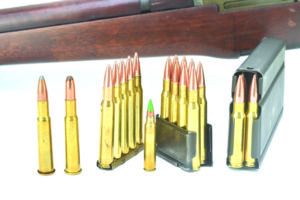
Springfield Armory (located in the city of Springfield in western Massachusetts) was an arsenal for the U.S. federal government from 1777 until its closing in 1968. Obviously known for their firearms, Springfield also helped introduce concepts such as interchangeable parts and the assembly-line method of mass production to the industrial world. Our sources tell us that these innovations allowed Springfield Armory, thus the Union, to outproduce Confederate firearms production by a factor of 32 to 1. Robert McNamara announced the closing of Springfield Armory in 1968, and it lay dormant until the Reese family bought the rights in 1974. Their initial efforts stayed true to the history of the brand with the production of M1 Garands, 1911-style pistols and a semi-auto version of the M-14. As of 2021, Springfield Armory is one of the larger producers and firearms importers in the U.S., having added AR-15 and AR-10 style rifles to the product mix, along with the excellent XD and XDM lines and more. The year of 2020 saw the release of the Waypoint, a lightweight hunting/precision bolt-action rifle.
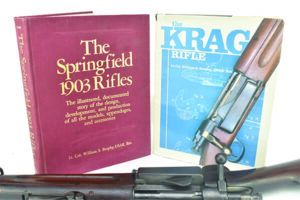
To see what these rifles could do, we fired them at American Shooting Centers in west Houston. We used a Caldwell TackDriver front bag and a large rear bag from T.A.B. Gear. Groups were shot with iron sights at targets 100 yards away. Keeping the age of the rifles in mind, we babied them with our ammo selections. For the Krag, we used 30-40 Krag Winchester 180-grain Power-Points. Ammo for this chambering is normally produced in limited quantities, so if you find some and you have a Krag, jump on it. Based on published advisories and a great deal of experimenting (see the June 2021 edition of Gun Tests for our report on Garands and gas plugs), we used reloads for the ’03 as well as the Garand. These consisted of 155-grain Sierra Match King bullets on top of Remington brass, CCI large rifle primers, and IMR 4895 powder. According to the manuals, our pressures should have been in the low 50,0000-psi range. The M1A was fed a well-proven 308 Winchester load consisting of 168-grain Sierra Match King bullets on top of Varget powder and Federal Gold Medal Match large rifle primers. Velocities were measured via Doppler radar as provided by LabRadar. Approximate values of the rifles were determined by researching internet auction sites such as Gunbroker.com to see what buyers were bidding on comparable items.
Here’s what to know about these rifles before you commit your hard-earned money to purchasing one.
Gun Tests Grade: B
~$800
Essentially, the Krag-Jorgensen was obsolete the moment it was adopted. Reloading was too slow, and the ammunition, while light years beyond black powder-loaded 45-70 rounds, performed very poorly in comparison to what was being used in Europe at the time. The U.S. government searched the world over trying to find a rifle that would compete with the German Mauser. They basically decided to copy most of the Mauser and produce it domestically, to the point where Mauser won a number of patent-infringement suits against the U.S. for our use of their action, bolt, and stripper-clip designs.
| Action Type | Bolt |
| Overall Length | 43.3 in. |
| Barrel Length/Twist | 24.0 in., 1:10 |
| Overall Height w/o Scope Mount | 7.5 in. |
| Weight Unloaded | 8.6 lbs. |
| Weight Loaded | 8.96 lbs. |
| Sight Radius | 21.5 in. |
| Action Finish | Parkerized |
| Barrel Finish | Parkerized |
| Magazine Capacity | 5 |
| Magazine Type | Internal box |
| Stock | Walnut |
| Drop at Comb | 1.5 in. |
| Drop at Heel | 2.0 in. |
| Bedding | NA |
| Buttplate | Steel |
| Length of Pull | 12.7 in. |
| Receiver Scope-Base Pattern | NA |
| Trigger Pull Weight | 3.4 lbs. |
| Safety | 3 position on bolt knob |
| Made In | USA |

The ‘03 went through a series of improvements, as do most weapons systems. One of the first things changed was the ammunition. Early loads (known as the 30-03) consisted of a 220-grain bullet at about 2300 fps, about the same load that was blowing up the Krags. That was changed to a lighter, faster pointed spitzer bullet some three years later. Named for the caliber of the cartridge (30) and the year of adoption (1906), this round was eventually named the 30-06 Springfield, which is still widely used, even today.
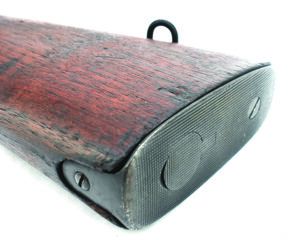
We have seen it opined that the ‘03 is a “refined” Mauser. History shows the ‘03 to be very accurate, though at the cost of somewhat fragile sights. Later versions (the 03A3) had a much-easier-to-see peep sight mounted further to the rear. The saying goes the Americans made a great target rifle, the Germans made a great hunting rifle and the Brits made a great battle rifle. Note that zeroing these rifles at 100 yards is almost impossible without changing front sights. The standard “battle zero” on the ‘03s was set for 500 meters and shoot high when aimed at a 100-yard target.
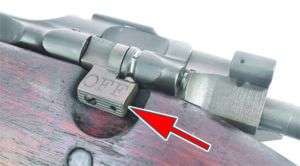
Our sample is a mid-model 03. That is great because early models had some heat-treating issues on the receiver. If you see a serial number under 800,000, be very careful. You are looking at an old rifle with a potentially brittle receiver. Ours has the “no finger groove” straight stock. Later curved “C” stocks had a bit more beef in the wrist and were easier to hold onto. Markings just below the bolt tell us this piece was rebuilt at the San Antonio Arsenal, probably around the end of WWII.
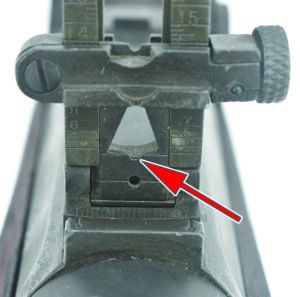
The standard ‘03 action has dual-opposed locking lugs on the front of the bolt and a third emergency lug that could impinge on the rear receiver ring in the event of catastrophic failure. As with the K98 Mauser, the ‘03 uses a controlled-feed system, thus capturing the case rim the instant it rises from the five-round magazine. The ‘03 even mounts a magazine cutoff that allows the rifle to be fully loaded with five rounds that the bolt rides over as it shoves single-fed rounds into the chamber. Every respectable ordnance officer just knew that having a fully charged, five-round magazine would lead to profligate expenditure of ammunition by the troops, and that just had to be controlled. The cutoff is a three-position switch on the left side of the receiver. The down position for the switch limits the travel of the bolt to the rear to the point where it will not pick up a shell from the magazine and feed it into the chamber. Up position of the switch allows movement of the bolt all the way to the rear and normal use of the magazine. Placing the cutoff in the center position and placing the safety in the central/vertical position allows the bolt to be removed to the rear for cleaning.
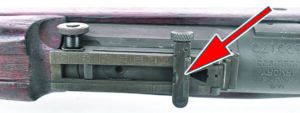
The ‘03 and its ilk are tools of war and the stock terminates, not in a squishy recoil pad, but in a steel buttplate. We once read of a Marine who offered that the 03 “kicked at both ends.” We concur. But it shot well. Groups averaged 3.04 inches. We were shooting at a 4-inch white bullseye (surrounded by orange) and we put nine out of ten in the bull. We were actually aiming about 6 inches below the bull with the sight on the lowest possible setting, but we’ll take that.
The Bottom Line
Which rifle would we start a collection with today?
- A sure bet, with great accuracy and gorgeous lines, would be the M1A. They are readily available, both new and used.
- The Garands are becoming more difficult to find, and their prices reflect that. Keep in mind that you are far more likely to find a great shooter than a true collector’s item. Still, good samples are available with a bit of looking and research. They are a fascinating piece of history from the Greatest Generation and are a must for the collector of American historical pieces.
- The 1903s, especially the versions before the A3 models, are our sentimental favorites, but their prices go up and selection lessens every year.
- As shooters, we probably enjoyed shooting the Krag-Jorgensen most of all. Be aware that unscrupulous souls have counterfeited many of the carbines, so do your homework carefully before adding a Krag to the collection. But if you find a good one, you’ll be transported back more than a hundred years every time you pull the trigger.
Range Data
| Rifle Load | Krag-Jorgensen 30-40 Krag Winchester Factory 180 Grain | 1903 Springfield 30-06 Springfield SMK Reload 155 Grain | M1 Garand 30-06 Springfield SMK Reload 155 Grain | M1A 308 Winchester SMK Reload 168 Grain |
|---|---|---|---|---|
| Average Velocity | 2253 fps | 2735 fps | 2818 fps | 2616 fps |
| Standard Deviation | 14.3 fps | 14.2 fps | 11.0 fps | 16.8 fps |
| Muzzle Energy | 2030 ft.-lbs. | 2572 ft.-lbs. | 2645 ft.-lbs. | 2357 ft.-lbs. |
| Best Group | 2.68 in. | 2.42 in. | 2.57 in. | 1.51 in. |
| Average Group | 3.37 in. | 3.04 in. | 3.36 in. | 1.72 in. |
Testing was done at American Shooting Centers on the west side of Houston. All shots were fired from a well-sandbagged position using a Caldwell TackDriver rear bag and a T.A.B. Gear large/heavy rear bag. Muzzle velocities were measured via LabRadar ($559).



























